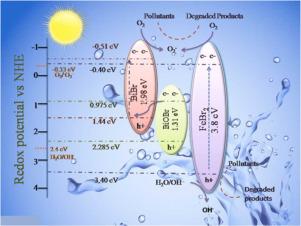Journal of Environmental Chemical Engineering ( IF 7.4 ) Pub Date : 2022-01-20 , DOI: 10.1016/j.jece.2022.107240 Moumita Mondal 1 , Mithun Halder 2 , S.K. Pradhan 1

|
Visible light-driven photocatalyst has been studied worldwide for wastewater treatment. In the present study, nanoplate-like heterostructured BiOBr/FeBr2/BiBr (BFB-a,b,c) novel photocatalysts have been synthesized by fine-tuning the pH (~6.46, ~7.71, ~9.16 for BFB- a, b, c samples, respectively) of the solution employing a facile water-bath method. Different physicochemical processes have been employed to characterize these heterostructured materials. The photocatalytic activity of the synthesized nanocomposites has been primarily investigated with the aqueous solution of an organic dye Rhodamine B (RhB) under visible light illumination. It is noticed that the photodegradation efficiency of synthesized nanocomposites has been significantly enhanced compared to the pure BiOBr compound. The photocatalytic activity also increases ~ 3 times with the increasing pH value. The BFB-c nanocomposite shows ~81% RhB degradation within 120 min under visible light and ~100% degradation with 0.1 mL of isopropyl alcohol. Scavenger tests have identified the proper radical of the photocatalytic reaction. The faster rate of the photocatalytic process has been interpreted by the interfacial consecutive dual Z scheme electron transfer mechanism. This photocatalytic technique has also been successfully applied to Methylene Blue (MB) and Methyl Orange (MO)organic dyes. The BFB nanocomposites can be used as an efficient visible-light-driven photocatalyst for the photodegradation of organic dye pollutants dissolved in wastewater.
中文翻译:

纳米板状异质结构 BiOBr/BiBr/FeBr2 纳米复合材料,通过去除有机染料提高废水处理的光催化活性:界面连续双 Z 方案电子转移
可见光驱动的光催化剂已在世界范围内被研究用于废水处理。在本研究中,纳米片状异质结构 BiOBr/FeBr 2/BiBr (BFB-a,b,c) 新型光催化剂已通过微调溶液的 pH 值(BFB-a、b、c 样品分别为~6.46、~7.71、~9.16)合成-沐浴法。已采用不同的物理化学过程来表征这些异质结构材料。合成的纳米复合材料的光催化活性主要在可见光照射下用有机染料罗丹明 B (RhB) 的水溶液进行了研究。值得注意的是,与纯BiOBr化合物相比,合成纳米复合材料的光降解效率显着提高。光催化活性也随着 pH 值的增加而增加约 3 倍。BFB-c 纳米复合材料在 120 分钟内表现出约 81% 的 RhB 降解 在可见光下分钟,用 0.1 mL 异丙醇降解约 100%。清除剂测试已经确定了光催化反应的适当自由基。界面连续双Z方案电子转移机制解释了光催化过程的更快速率。这种光催化技术也已成功应用于亚甲基蓝 (MB) 和甲基橙 (MO) 有机染料。BFB纳米复合材料可用作有效的可见光驱动光催化剂,用于光降解溶解在废水中的有机染料污染物。











































 京公网安备 11010802027423号
京公网安备 11010802027423号